Beauty, as the cliché goes, is in the eye of the beholder. Nevertheless, despite a blocky-ness which cannot possibly compare to the Unreal Engine 5 marvels being produced today, there's a certain undeniable beauty about the original Tomb Raider which is absent in nearly all of its sequels and reboots. That isn't to say that games like Tomb Raider: Underworld or Shadow of the Tomb Raider aren't pretty--far from it. They're gorgeous and cinematic in ways of which those early Core Design incarnations could hardly have dreamt. But the incredible graphical fidelity of the modern TR titles isn't what I'm getting at here. I'm talking about the feeling of beauty within a game. Perhaps some of this can be attributed to the rose-colored glasses of nostalgia, but there's a very sweet spot in mid-90s 3D gaming where the programmers are able to deliver just enough fidelity in games to make it clear what they're trying to depict, contrasted with hardware that requires active participation from the viewers to fill in the gaps with their imaginations. For my money, Tomb Raider, the 1996 original running in MS-DOS at 640x480 resolution, is queen of that particular hill.
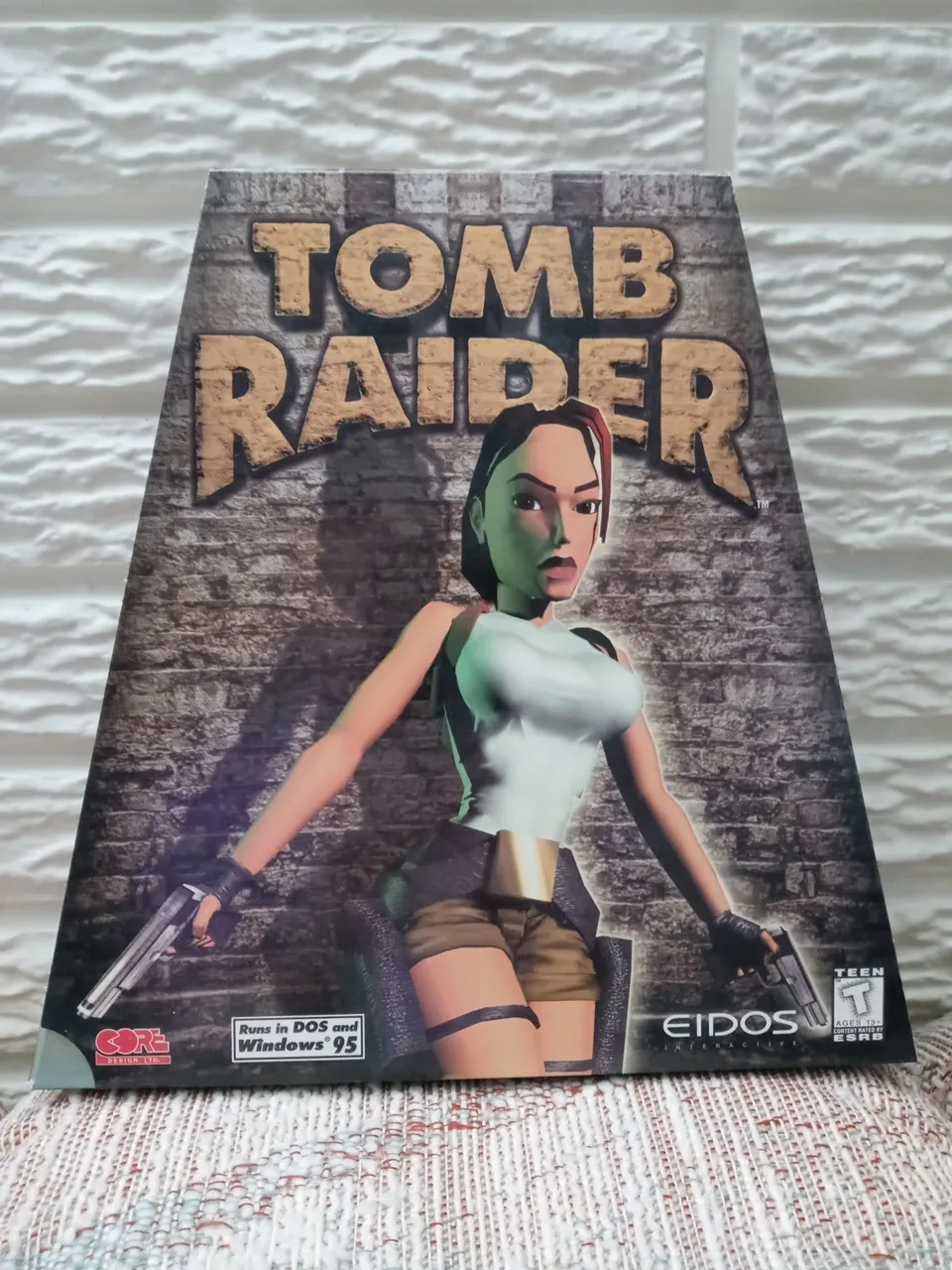
The original Tomb Raider is a vastly different experience from every game which came after it. Core Design was taking a similar journey to their protagonist: navigating a world that was still very new to all of us. ID Software had Quake on store shelves that summer. Shigeru Miyamoto and his team at Nintendo beat Tomb Raider to the 3D platformer scene with the North American release of Super Mario 64 in September. But a mere two months later, PC gamers got their hands on the archetypal pyramid-shaped box pictured above. As a result, the PC gaming world exploded and reformed into something entirely new, and nothing would ever be the same.
One of the things I love observing as a gamer is the way developers work within the constraints of the system. Tomb Raider illustrates this perfectly, utilizing a combination of textured polygons and 2D sprites to render its world. Here's an example from the game's first level, 'Caves':
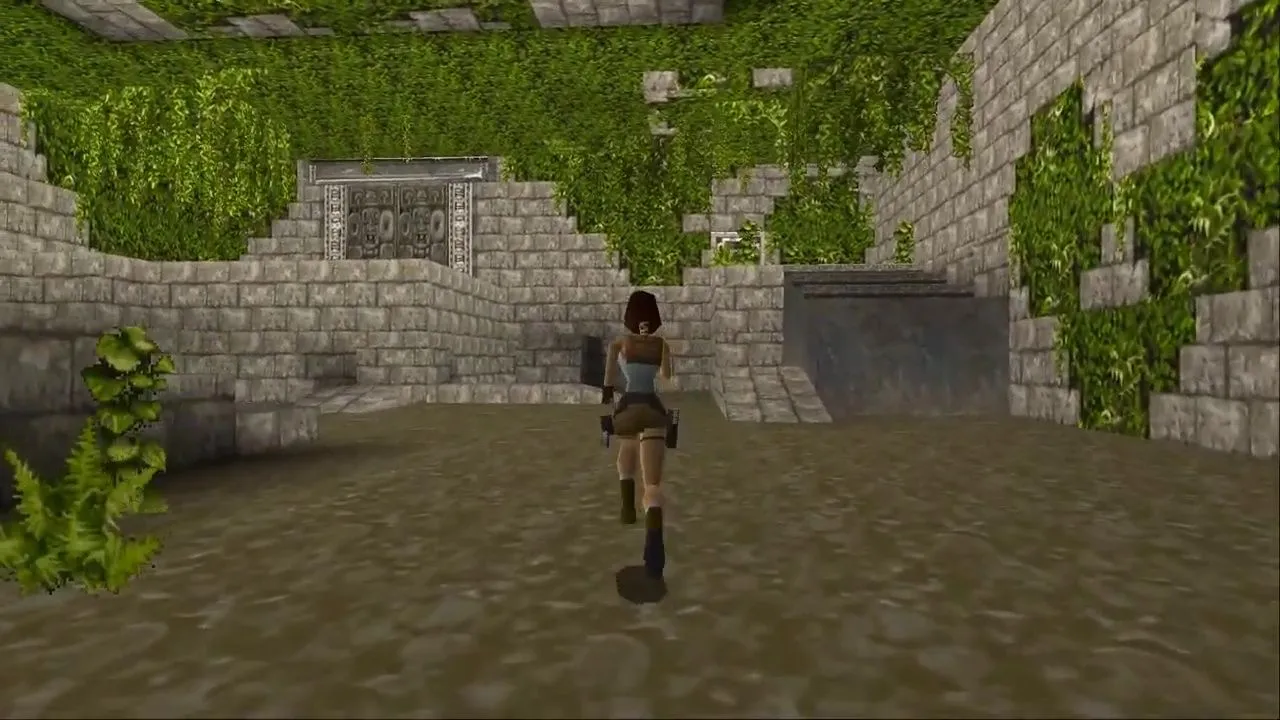
The plants to Lara's left are two-dimensional sprites which behave like sprites in Doom: they're always viewed from the same angle no matter how the player approaches them. But most of the rest of the greenery you see sprinkled around the scene is done as texture work applied to the walls and ceiling, with some extra sprites thrown in here and there to add a sense of depth.
This being a DOS game from 1996, the textures are low-resolution. When viewed up close, or from a static image like this one, they really don't look all that impressive. But since the point of Tomb Raider is to generally keep Lara in motion, always on the move and pushing forward, the in-game result is more than adequate. Sure, if you stop and stare at the wall from as close as the camera will allow, those plants look like the pixelated, 8-bit forgeries that they are. But the effect they generate when viewed, in motion, from across the room, is different. It's "good enough" to convey what the developers wanted to showcase with the technology on hand. My imagination does the rest.
That, to me, is beautiful.
I also love the water effects for much the same reason.
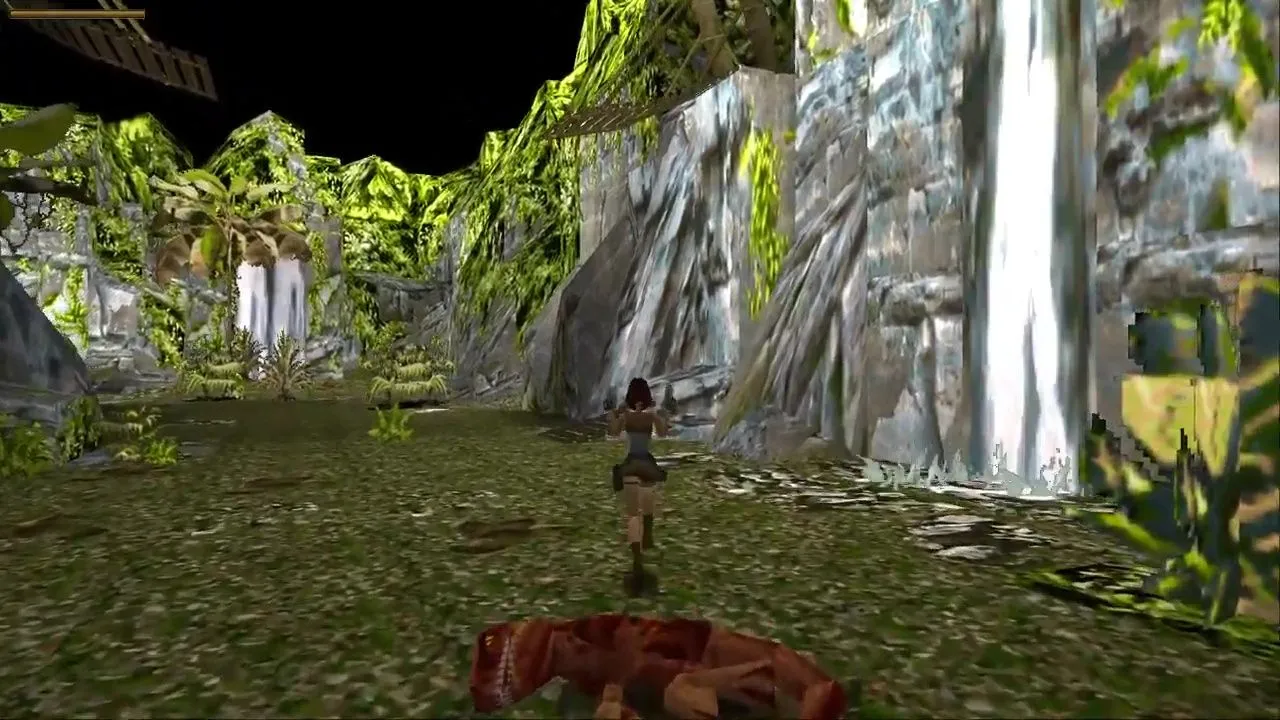
Now, ignore the dead velociraptor in the foreground and look to Lara's right. That's Tomb Raider's idea of a waterfall. Again, it's difficult to convey in a static image, but waterfalls in Tomb Raider are a 4-frame cascading water texture applied to the flat surface of a wall, with another 8-frame splashing water sprite applied to the floor in front of it. Believe me, it's as janky when seen in action as it looks in this image.
And yet, it still works, and there's a beauty in the way Core approached this. The original Tomb Raider engine was extraordinarily limited at producing effects it was not designed to produce. Core built the engine to be capable of rendering large open spaces comprised mostly of 3D polygons with textures mapped to their varying angles and vertices, along with some low polygon models like the player and their occasional animated adversaries, but it was still a DOS application. There was only so much memory to go around. So when the level design required elements it wasn't built to handle, the builders had to work within those constraints. The resources necessary to construct three dimensional waterfalls complete with full particle effects for cascading water droplets simply weren't there. So instead, they built the only type of waterfall they could.
It looks rather silly.
It's also rather elegant in its simplicity, isn't it? But that's classic Tomb Raider for you.
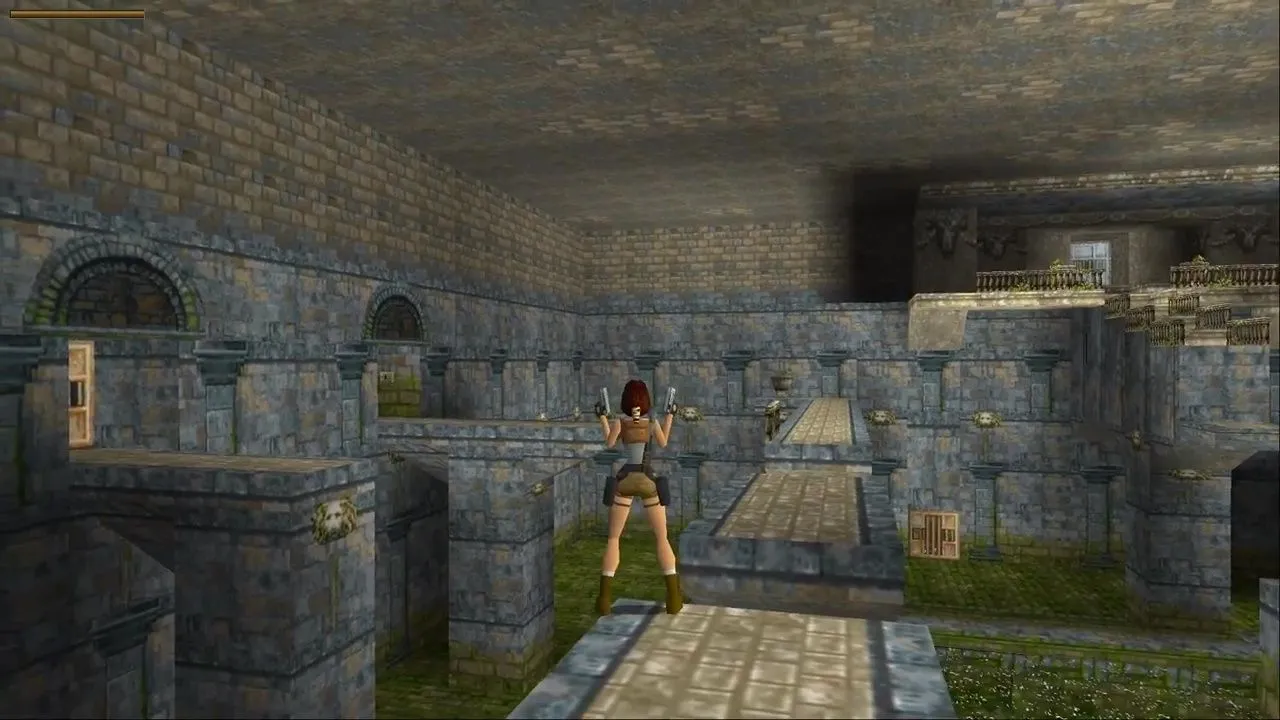
The final aspect of the original game's beauty which, in my opinion, has been diminished more and more through the various sequels and reboots, is the sense of abject loneliness which permeates every level. Human antagonists in the first game are relatively rare; your first fight with one doesn't occur until the conclusion of the game's fourth level, The Tomb of Qualopec. Given there are only fifteen total stages in the original game, the fact you spend the first quarter of them without a single other person around puts the player in a singular state of mind. Every subsequent game in the series breaks this convention, either by sprinkling human bad guys throughout the levels, or by placing Lara in radio or physical contact with friends and associates from time to time.
But in the first game, meeting other people is a rarity. For the bulk of the game, the only person around is Lara. She's alone with only your thoughts as company. And while there's occasional gunplay as she's confronted with the local wildlife, there are still large stretches of the game where she needn't draw a weapon at all.
Placing a player alone with just the environment for companionship results in a unique mental state. With your lead character dropping no sarcastic one-liners every few seconds, and the soundtrack being entirely ambient and mostly silent, you're left with only your thoughts to fill the void. And who could blame you for taking the time to admire the scenery, to explore what is possible, to enjoy the serene beauty of the empty caverns, deserts, and open-air valleys around you?
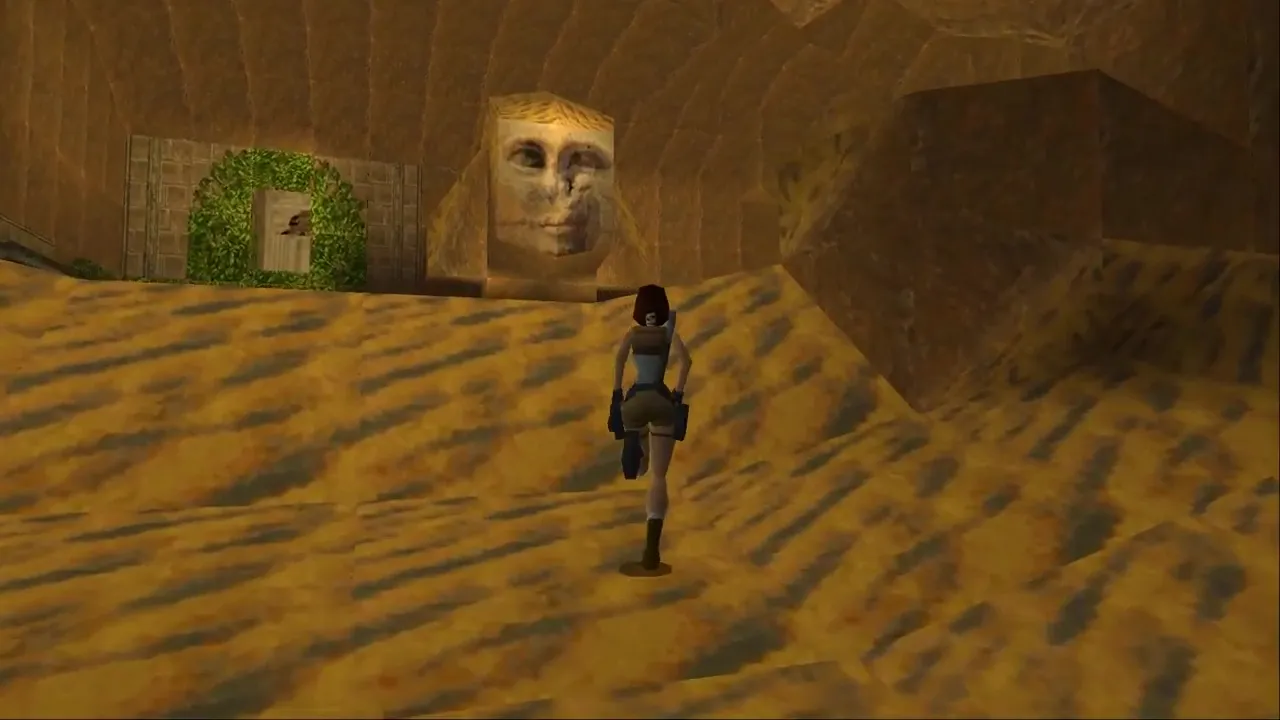
For these reasons, Tomb Raider always held a splendor which isn't present, at least not in the same way, in the rest of the series. And while most of the other games are arguably better with their improved graphics, better resolutions, higher polygon counts, expanded play mechanics, more complex puzzles, more convoluted stories, smoother FMV sequences, more intuitive controls, and other bells and whistles, there's never been one as content to simply rest content in its quiet beauty as the 1996 original.